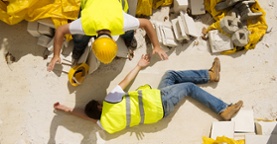Construction areas can be dangerous places for both employees and non-employees. Electrical accidents, excavation accidents, and falls are only some of the incidents that may result in serious personal injury. In fact, according to reports by the Occupational Safety and Health Administration (OSHA), falls are the leading cause of death in construction. However, just because a job is dangerous, does not mean that some injuries aren’t preventable. As a result, it is important to be aware of the things that are required of employers in order to protect employees and other persons from injuries resulting from falls.
OSHA Requirements
The Occupational Safety and Health Administration regulates working conditions for many different types of workplaces, including construction workplaces. Naturally, one of the focal points of OSHA regulation is ensuring safe standards in the workplace. Due to the seriousness of falls at construction workplaces, OSHA has devoted an entire subpart to the regulation of falls, 29 CFR 1926 Subpart M. Below is a quick overview of the regulations OSHA has in place to prevent injuries resulting from falls.
Fall Protection Systems
One of the first things OSHA may require of employers is that they have “fall protection systems” in place under certain circumstances. In Pennsylvania fall protection is required if a worker is higher than 6 feet above ground. Some areas for which OSHA has required fall protection systems include:
- unprotected sides and edges
- leaning edges
- hoist areas
- holes
- ramps, runways, and other walkways
- excavations
- roofing work
OSHA also requires certain fall protection systems to prevent tools or other objects from falling, which include rail guards, canopy structures, and barricaded areas.
Systems Criteria and Practices
In addition to regulating where the fall protection should be placed, OSHA has stated what kinds of protection an employer must install and use. These protections include:
- guardrails systems
- safety net systems
- personal fall arrest systems
- positioning device systems
- warning line systems
- safety monitoring systems
Training Requirements
Without the proper training, however, all of the systems and protections would count for little. Under the OSHA requirements, employers are required to “provide training programs to each employee who might be exposed to fall hazards.” Topics on which OSHA requires employers to provide training include:
- The nature of fall hazards in the work area
- The correct procedures for fall protection systems
- The use and operation of the various fall protection systems in use
- The role of each employee in the safety monitoring system
- The role of employees in the fall protection plan
In addition to these training requirements, OSHA also requires employers to provide certification for each employee when an employee has completed the required training. While training can be completed either through the current employer or through a prior employer, the current employer must still provide certification that the employee is properly trained in such matters. Finally, if an employee has undergone training, but does not have the requisite knowledge or skills, the employer is required to retrain the employee.
Overall, there are many requirements that are in place to ensure a safe environment and to limit the chance of dangerous construction accidents from occurring. While having these requirements in place protect people, they are only useful if employers adhere to them. If you or a loved one has been injured in a construction accident, then contact one of our skilled, caring attorneys at Stampone Law to schedule a free, confidential consultation.
